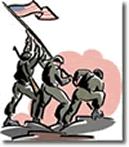
Grades 3-5

Don't have an account yet? Sign up for free
Don't have an account yet? Sign up for free

In World War II pennies were made of steel and zinc instead of copper and women were working at jobs that men had always been hired to do. Why? Because during war times, scarcity forces many things to change!
 You are an economic spotter! You can spot economic concepts in history. This lesson will take you back in time when the world was at war! During World War II, the United States was forced to make changes. There was a huge problem with scarcity! Scarcity is whenever there are limited resources and unlimited wants. Scarcity exists whenever the wants for a good or service exceed the resources needed to make that good or service. Can you spot the scarce resources needed to help the US win WWII?
You are an economic spotter! You can spot economic concepts in history. This lesson will take you back in time when the world was at war! During World War II, the United States was forced to make changes. There was a huge problem with scarcity! Scarcity is whenever there are limited resources and unlimited wants. Scarcity exists whenever the wants for a good or service exceed the resources needed to make that good or service. Can you spot the scarce resources needed to help the US win WWII?
Start the lesson with some questions to get the students thinking about how the United States was different in the 1940’s than it is now. Questions such as: What are you going to be when you grow up? Can girls do the same jobs as boys? If you were born in 1900, would girls be able to have the same job as boys? Do you think there was a time when the United States PREFERRED women in jobs normally held by men? What was going on that women NEEDED to hold the jobs that were normally held by men?
Explain that SCARCITY was a serious issue in World War II. Scarcity occurred when our wants were greater than the resources were available to satisfy those wants. Scarcity affected our choices on how to use our resources.
Humans were not the only scarce resources. We had a scarcity of natural resources too. Ask students: What are pennies made of today? What were they made of 50 years ago? Why were they made of steel during WWII?
Capital resources were scarce, also. Tell students that they will read a story in this lesson and they are to keep track of all the scarce resources that is discussed on the site. The students will also note what choices the United States made to deal with those scarce resources.
After the lesson, use the following Decision Making Grid handout and complete the decision making grid together. The Problem: There is not enough oil to provide gasoline to all the war related equipment. How can the United States get enough oil for the war?
Example of Alternatives:
Examples of Criteria:
Show that countries during war must make hard decisions and must deal with SCARCITY issues.
The United States had a scarcity problem at the start of World War II. The United States men to be soldiers, factories to make equipment, metals to build equipment, extra food to feed the soldiers, nylon to make parachutes, etc. All of the country’s resources became even more scarce! The United States had some tough choices to make.
Have your students think about the natural, human, and capital resources used in production of war materials. Natural resources include trees, water, minerals, oil (to make gasoline), and many more. What will a country do if it does not have enough oil for ALL the planes, ships, tanks, cars, etc. that need gasoline? [divert the use of oil away from the homeland to the war efforts, find more oil, or find a substitute for oil.] So, the country must make a choice. Should the United States let the civilians back home have the gasoline made from oil, or send the gasoline to the war equipment? [send to the war effort]
Have your students discuss and recognize that human resources, also called labor, were the men and women (women worked before WWII!) who worked to produce goods and services. The United States needed men to be soldiers. So, our human resources (the men of our country) were needed to go to war. Men became an even scarcer resource. Remember, scarcity means that people cannot have all the goods and services they want, so, they must choose some things and give up others. What do you think the country does when the men who worked in farms, factories, and businesses had to leave their jobs so that they could become soldiers? [the country must let another group fill those positions] 
Whenever a choice is made, something is given up. In the case of the men leaving their jobs to become soldiers, what was given up? [trained workers leaving their jobs] Likewise, what did the country gain? [soldiers]
Capital resources include goods such as tools, equipment, machines, and buildings. Many capital goods were needed to produce war materials. How could America’s factories make cars for people in the United States, and at the same time make more tanks? [they couldn’t] So, the country had to make a choice: use resources to help the war effort and go without at home or satisfy the wants of the civilians and go without on the war front. What choice do you think the United States made? [use the scarce resources to help the war effort]
The war placed additional demands on scarce natural, human, and capital resources. Go to the The Great Depression and World War II activity and see if you can spot examples of how people in the United States solved some of its scarcity issues. You will be searching for examples in the Great Depression and World War II section. Print out the Great Depression and World War II worksheet and list all the scarce items you see on the site. Put this scarce items in the correct column (natural resource, human resource, or capital resource). Then write a sentence or two on what the United States gained and what they gave up when they made the choice to send the scarce resource to the war effort.
Let’s see how you did!
Here’s how the country coped with the scarcity of resources. The United States government started a rationing program during World War II, families could buy only so much gas, sugar, meat, and other goods. By rationing food in this way, the government could make sure that adequate supplies of food would be available for the war effort.
Check to make sure that your students marked their chart that the country gained another human resource when they sent the men to war? Before that time, very few women worked away from the home–not, at least, in heavy industrial jobs. But when all the men left for the war, someone had to fill their jobs. Have your students go the “https://www.archives.gov/exhibits/powers-of-persuasion ” page at the national archives, scroll down to the section “It’s A Woman’s War, Too” and see the posters urging women to take jobs.
 The war effort trained a part of our population that had never been trained for technical jobs before! The women in America stepped up and did the job! STANDARD OF LIVING is a comparison of how the people of a country are doing, in terms of wealth compared to an earlier time. What do you think that the training of women meant to the country as far as the future standard of living? Think this through…women who were never trained for factory jobs before became technical workers. Women who never had a great deal of money before, started jobs that paid them better than they ever had been paid. When the men came back from the war, the country had double the amount of workers that were technically trained. You can see that the future standard of living is going to be higher because of the training the women got from their jobs.
The war effort trained a part of our population that had never been trained for technical jobs before! The women in America stepped up and did the job! STANDARD OF LIVING is a comparison of how the people of a country are doing, in terms of wealth compared to an earlier time. What do you think that the training of women meant to the country as far as the future standard of living? Think this through…women who were never trained for factory jobs before became technical workers. Women who never had a great deal of money before, started jobs that paid them better than they ever had been paid. When the men came back from the war, the country had double the amount of workers that were technically trained. You can see that the future standard of living is going to be higher because of the training the women got from their jobs.
There were new factories and new technology proved that production was faster if things were built on an assembly line. Remember that according to the story, it had previously taken a year to build a ship? But with new technology and pressure created by the great need for ships, the job later could be done in a week! Do you think all these changes meant that the future standard of living was going to be lower or higher in America? [higher]
Reinforce with your students that the standard of living in America was raised as a result of the new technology developed during the war and newly trained women who joined the workforce. Even though many resources were scarce, our government limited the domestic use of those resources and sent them off for the use in the war effort–or it found new resources to be used as substitutes for the scarce items.
Draw: Have your students draw their own WWII Posters. How would they convince women to participate in the war effort?
Write: Have your students think about these questions and write a paragraph telling what you think.

Grades 3-5

Grades 6-8, 9-12

Grades 6-8, 9-12

Grades 3-5
